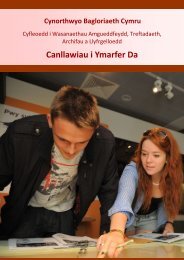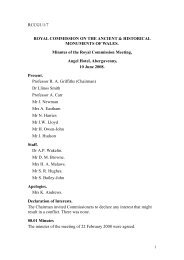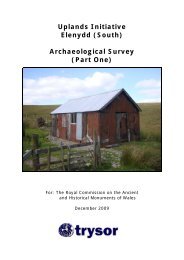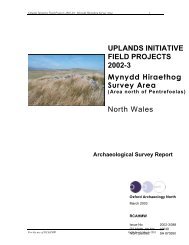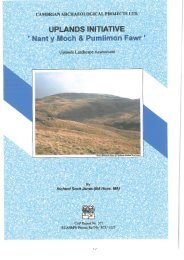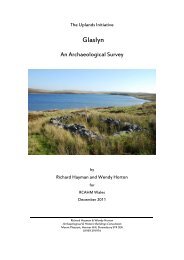Cwm Prysor (Merionethshire) - Royal Commission on the Ancient ...
Cwm Prysor (Merionethshire) - Royal Commission on the Ancient ...
Cwm Prysor (Merionethshire) - Royal Commission on the Ancient ...
Create successful ePaper yourself
Turn your PDF publications into a flip-book with our unique Google optimized e-Paper software.
ArcHeritageiiiSUMMARYAn archaeological survey was undertaken at <str<strong>on</strong>g>Cwm</str<strong>on</strong>g> <str<strong>on</strong>g>Prysor</str<strong>on</strong>g> between May and October 2012 byArcHeritage, <strong>on</strong> behalf of <strong>the</strong> RCAHMW. The survey was undertaken as part of <strong>the</strong> UplandsSurvey Initiative. Part of <strong>the</strong> survey was undertaken by students of <strong>the</strong> University of Sheffieldas a field school for an MA in Landscape Archaeology. The project comprised desk-basedassessment and a field identificati<strong>on</strong> survey to a Level 1 standard.The <str<strong>on</strong>g>Cwm</str<strong>on</strong>g> <str<strong>on</strong>g>Prysor</str<strong>on</strong>g> survey area, centred <strong>on</strong> SH 759 343, is located to <strong>the</strong> sou<strong>the</strong>ast ofTrawsfynydd, in <strong>the</strong> Unitary Authority of Gwynedd and within Snowd<strong>on</strong>ia Nati<strong>on</strong>al Park. Itcovers an area of 25.173 km 2 . The majority of <strong>the</strong> survey area was part of <strong>the</strong> TrawsfynyddMilitary Range during <strong>the</strong> first half of <strong>the</strong> 20 th century. The eastern extent of <strong>the</strong> survey area ispart of <strong>the</strong> Migneint-Arenig-Dduallt SSSI. The height above sea level varies from 240m to620m.The desk-based research identified 83 known archaeological sites within <strong>the</strong> survey area,including two prehistoric to Romano-British settlement sites, a possible prehistoric ormedieval deserted rural settlement, gold mines, Roman roads and a Roman tile kiln, and postmedievalfarmsteads. The survey identified a total of 1540 sites, including <strong>the</strong> previouslyrecorded sites. Not all of <strong>the</strong> previously recorded sites were identified <strong>on</strong> <strong>the</strong> ground.The survey identified a fur<strong>the</strong>r prehistoric hut group and a cairnfield, <strong>the</strong> latter being a rareexample of this type of site within <strong>the</strong> area. Fur<strong>the</strong>r possible hut sites were recorded, though<strong>the</strong>se could not be c<strong>on</strong>clusively identified as prehistoric. Possible burial mounds were alsoidentified. Only <strong>on</strong>e medieval l<strong>on</strong>ghouse site was recorded, though fur<strong>the</strong>r structures and fieldboundaries may have had a medieval origin. These were located in <strong>the</strong> vicinity of <strong>the</strong> proposeddeserted rural settlement, and fur<strong>the</strong>r survey is recommended in this area to record <strong>the</strong>features in more detail.A total of 994 sites of probable post-medieval date were recorded. These mainly relate toagriculture and subsistence, and comprise seven farmsteads, around 100 sheep folds andstock enclosures, field boundaries, track ways and p<strong>on</strong>ds. Industrial post-medieval sitesincluded small quarries, copper and gold mines, and numerous peat cuttings. The farmsteadswere all located <strong>on</strong> <strong>the</strong> lower ground to ei<strong>the</strong>r side of <strong>the</strong> Af<strong>on</strong> Gain, and may have originatedin <strong>the</strong> late medieval to early post-medieval periods. They were aband<strong>on</strong>ed in 1905 inassociati<strong>on</strong> with <strong>the</strong> purchase of <strong>the</strong> land by <strong>the</strong> War Department.A large proporti<strong>on</strong> of <strong>the</strong> modern sites related to military training, including firing rangeblockhouses, telecommunicati<strong>on</strong>s structures and gun emplacements associated with artillerytraining. There were also practice trenches, bunkers, slit trenches and fox holes characteristicof First World War infantry training. Much of <strong>the</strong> area is covered by shell and mortar craters.O<strong>the</strong>r modern sites related to stock management and transport routes.<str<strong>on</strong>g>Cwm</str<strong>on</strong>g> <str<strong>on</strong>g>Prysor</str<strong>on</strong>g> Upland SurveyArcHeritage Survey Report Report No 2013/8


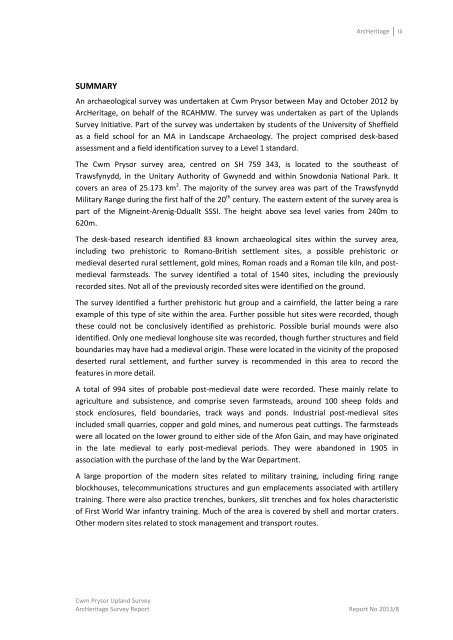

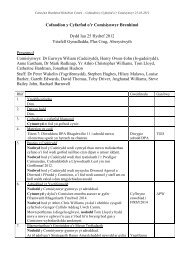
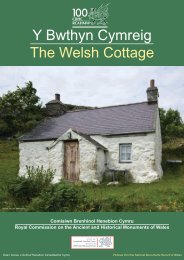

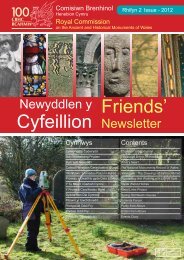
![The Source of the Usk Walk [2012 PDF]](https://img.yumpu.com/49285699/1/190x245/the-source-of-the-usk-walk-2012-pdf.jpg?quality=85)

